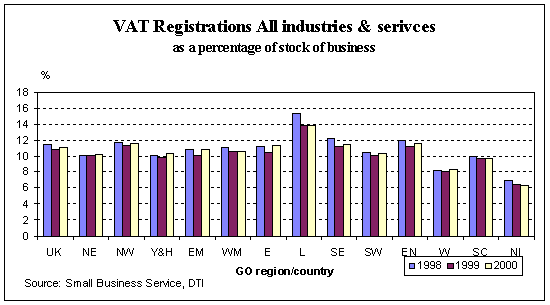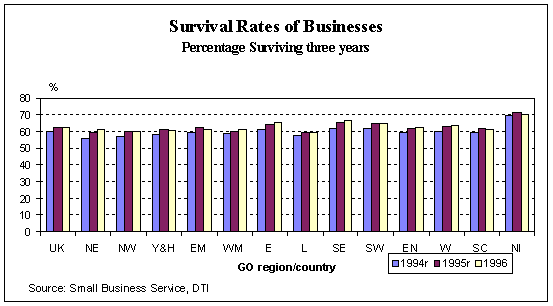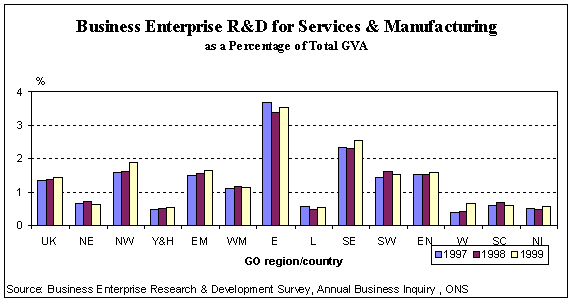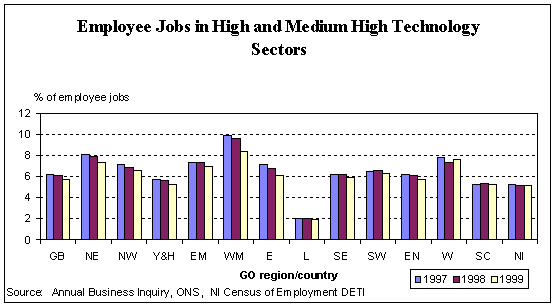Section 4: Capital11. Business Registrations and Survival Rates This measure reflects entrepreneurial activity in the formation rate of new firms and their ability to survive their first three years. VAT Registrations The measure of business formation is the number of new Value Added Tax (VAT) registrations in the year as a percentage of enterprises registered for VAT at the start of the year. The figures in Table 11(a) show VAT registrations for manufacturing, services and the rest of the economy. During 2000, formation rates were higher among service industries (UK=12.8%) than in manufacturing industry (7.6%). Formation rates have been falling in the manufacturing sector since 1996 (down from 8.6% in 1996 to 7.6% in 2000) while rates in service industries have risen (from 12.2% in 1996 to a peak of 13.4% in 1998). London had the highest business formation rates in all the years shown for both manufacturing and services, and for 'other' industries. The relative positions of the other regions and countries did not change markedly between 1994 and 2000, but Yorkshire and the Humber moved from having the lowest formation rate in manufacturing in English regions, to having a higher than average formation rate for manufacturing businesses during 2000. Comparisons between regions should be made with care, as there are areas where the stock of businesses is relatively low, so the rate of business formations will be artificially inflated. In addition, the rate of new business formation may increase at a time when VAT registrations are falling if the stock of VAT registered businesses is decreasing at a faster rate. Registration rates also vary across industry sectors. Regions with a larger proportion of industries with a high formation rate might be expected to have higher than average rates of business formation. Some sectors have higher start up rates than others or vary more than average with the economic cycle. A high start up rate may be due partly to a high concentration of such sectors. Business Survivals Business Survival Rates show the proportion of businesses remaining registered for VAT three years after their initial registration (i.e., the year shown in Table 11(b) + 3). Chart 11(b) and Table 11(b) show that the 3 year survival rates for businesses registered between 1993 and 1996 were generally around the 60% mark for most regions, with rates in the South East and Northern Ireland higher than those for the UK as a whole. This is particularly evident for firms registered during 1995 and 1996 in Northern Ireland, where more than 70% were still registered for VAT three years later. This compares to a survival rate of just over 62% for the UK as a whole for the same period. Survival rates in the UK as a whole were rising. Three year survival rates were 59.6% for those first registered in 1994, 62.3% for those first registered in 1995, and 62.5% for those first registered in 1996. The Chart shows that this pattern was repeated in most English regions, and also in Wales. Chart
11(a) 
Chart 11(b)

12. Research and Development and Employment in High and Medium High Technology Industries These measures idicate the amount of Research & Development (R&D) activity carried out by manufacturing and service sector firms and the number of employee jobs in high technology industries. Expenditure on R&D measures the extent to which businesses are developing and exploiting new technology, software and ideas. It has also been shown to generate important spillover benefits for both other firms and society as a whole. High R&D activity can be a stimulant to the competitiveness of firms within a region. Chart 12(a) represents the value of R&D carried out by the combined manufacturing and service sectors as a proportion of regional GVA for 1997 to 1999. The R&D data used in this Chart and in Table 12(a) are taken from the Survey of Business Enterprise Research and Development and the regional economic accounts, both produced by the ONS (see Definitions). It is evident that R&D as a proportion of GVA was significantly higher in the East of England than any other region, with proportions relatively low in the North East, Yorkshire & the Humber, London and in Wales, Scotland and Northern Ireland. Across regions, expenditure on R&D is in general, higher in the manufacturing sector than in the services sector. Chart 12(b) and Table 12(b) detail the proportion of employee jobs in high and medium high technology manufacturing industries. As can be observed from these, 5.6 % of all employee jobs in the UK were classified as high or medium high technology manufacturing industries in 1999, a fall of around half of a percentage point on 1995. In 1999, the lowest proportion of high and medium technology jobs was in London (1.9%).
Chart 12(a)

Chart 12(b)

Home - Search - Site Map - Contact Us |